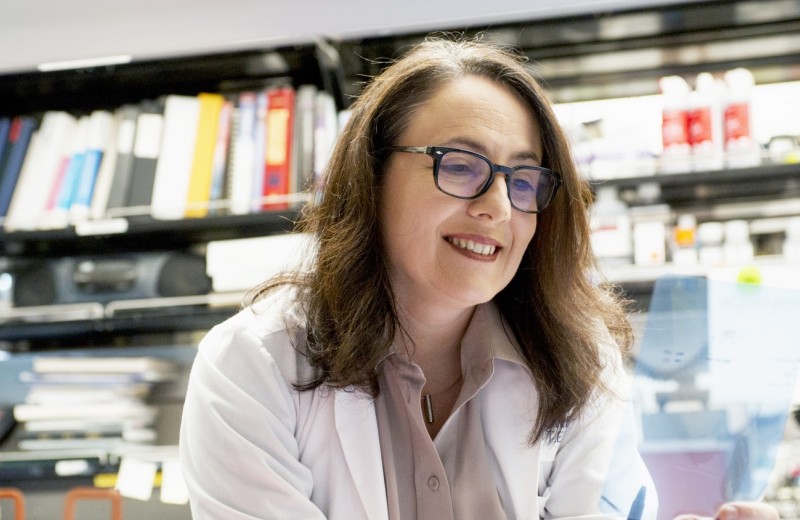Gladstone NOW: The Campaign Join Us on the Journey✕

SAN FRANCISCO, CA—Scientists at the Gladstone Institutes have enhanced our understanding of how a protein linked to Alzheimer's disease keeps young brains healthy, but can damage them later in life—suggesting new research avenues for treating this devastating disease.
In the Journal of Neuroscience, available online today, researchers in the laboratory of Yadong Huang, MD, PhD, have uncovered the distinct roles that the apoE protein plays in young vs. aging brains. These findings, which could inform the future of Alzheimer's drug development, come at a time of unprecedented challenge and need.
“By the year 2030, more than 60 million people worldwide will likely be diagnosed with Alzheimer's, but we are still grappling with the disease's underlying biological mechanisms,” said Dr. Huang, an Alzheimer's expert at Gladstone, an independent and nonprofit biomedical-research organization. “However, with this research we've shed new light on these complex processes—and how we could modify these processes to fight this disease.”
The molecular mechanisms behind Alzheimer's have long evaded scientists. Early studies found that different types, or variants, of the apoE gene—including apoE3 and apoE4—influence one's genetic risk for developing the disease. The apoE4 variant is the major genetic risk factor for the disease, while apoE3 is less risky—and far more common. From among these variants, everyone inherits two—one from each parent—that provide a blueprint for making the protein known simply as apoE. Previous findings revealed a complicated interplay between apoE and another protein called amyloid-beta (Aβ), which is present in increased quantities in the brains of Alzheimer's patients, but the exact nature of this complex relationship remains unclear.
Recent research by another group found that a drug that boosted apoE protein levels also reversed the build-up of Aβ in mice genetically modified to mimic Alzheimer's. So some scientists have theorized that boosting apoE levels could be beneficial in slowing the disease's progression in humans, and several groups have begun to explore this therapeutic strategy.
In this study, Dr. Huang and his team tested this idea. They genetically modified mice to have either human apoE3 or apoE4 and then monitored them for any subsequent build-up of toxic Aβ in their brains as they aged.
“We thought a straightforward relationship existed between apoE protein levels and Aβ, and that boosting apoE levels in these mice would promote—not halt—the build-up of Aβ,” explained Gladstone Postdoctoral Fellow and lead author Nga Bien-Ly, PhD.
The team's experiments revealed both surprising and intricate roles for apoE. In young mice, apoE proteins produced by all variants of the apoE gene—even the risky apoE4 variant—are essential because the protein they build helps clear away excessive amounts of Aβ. But as the mice aged, this process began to malfunction—especially in those mice with two copies of the apoE4 gene but also in mice with two copies of apoE3. As apoE protein levels rose, Aβ began to accumulate. But in mice mutated to have only one copy of the apoE gene—either apoE3 or apoE4—apoE protein levels dropped by half and Aβ build-up was reduced. These results indicated that Aβ build-up isn't associated only with a specific apoE variant, but instead is also related to the overall amount of apoE protein produced as the brain ages.
“Our findings suggest that reducing levels of proteins produced by either apoE3 or apoE4—rather than raising them—could be key to lowering Aβ build-up in the brain,” said Dr. Huang, who is also an associate professor of neurology at the University of California, San Francisco, with which Gladstone is affiliated. “We hope that our research could spur new therapies that successfully combat Alzheimer's at the molecular level—putting us one step ahead of this deadly disease.”
Other scientists who participated in this research at Gladstone include Anna Gillespie, David Walker and Seo Yeon Yoon. Funding came from a variety of sources, including the National Institutes of Health.
Support Discovery Science
Your gift to Gladstone will allow our researchers to pursue high-quality science, focus on disease, and train the next generation of scientific thought leaders.
Science in Seconds | The Thinking Microscope: Research Powered by an AI Brain
Science in Seconds | The Thinking Microscope: Research Powered by an AI Brain
In this video, Steve Finkbeiner and Jeremy Linsley showcase Gladstone’s groundbreaking “thinking microscope”—an AI-powered system that can design, conduct, and analyze experiments autonomously to uncover new insights into diseases like Alzheimer’s, Parkinson’s, and ALS.
Gladstone Experts ALS Alzheimer’s Disease Parkinson’s Disease Neurological Disease Finkbeiner Lab AI Big DataKaterina Akassoglou Receives Zenith Fellows Award to Advance Alzheimer’s Research
Katerina Akassoglou Receives Zenith Fellows Award to Advance Alzheimer’s Research
Akassoglou has opened doors to understanding how the blood protein fibrin is involved in Alzheimer’s and other neurodegenerative diseases.
Awards News Release Alzheimer’s Disease Center for Neurovascular Brain Immunology Akassoglou LabMeet Gladstone: Oscar Yip
Meet Gladstone: Oscar Yip
Oscar Yip is advancing Alzheimer’s research in Yadong Huang’s lab at Gladstone while drawing inspiration from his family, community, and his broader goal of helping patients.
Graduate Students and Postdocs Profile Alzheimer’s Disease



